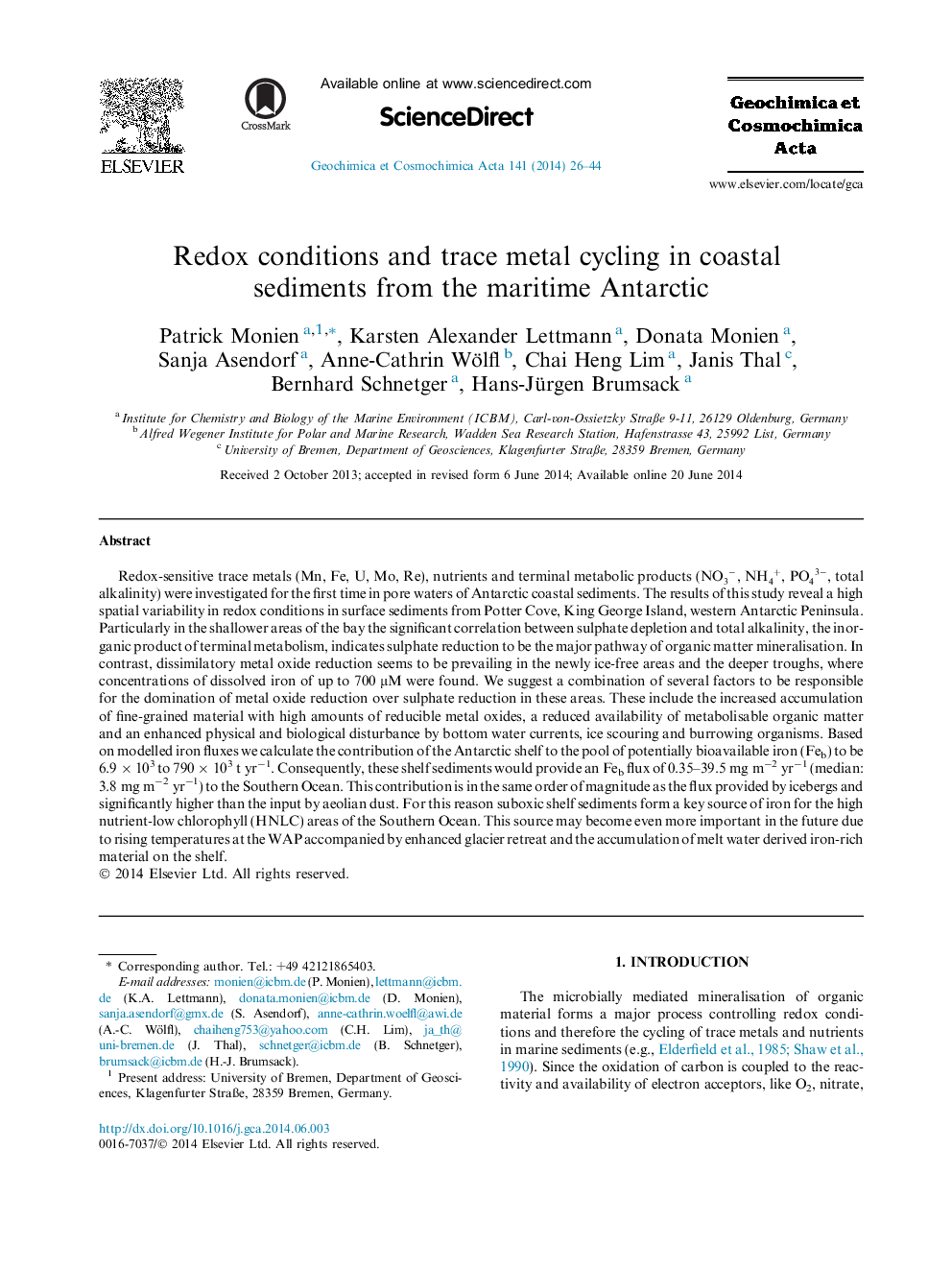| کد مقاله | کد نشریه | سال انتشار | مقاله انگلیسی | نسخه تمام متن |
|---|---|---|---|---|
| 6438199 | 1638016 | 2014 | 19 صفحه PDF | دانلود رایگان |
عنوان انگلیسی مقاله ISI
Redox conditions and trace metal cycling in coastal sediments from the maritime Antarctic
ترجمه فارسی عنوان
شرایط ردوکس و ردیابی دوچرخه سواری فلز در رسوبات ساحلی از قطب جنوب دریایی
دانلود مقاله + سفارش ترجمه
دانلود مقاله ISI انگلیسی
رایگان برای ایرانیان
موضوعات مرتبط
مهندسی و علوم پایه
علوم زمین و سیارات
ژئوشیمی و پترولوژی
چکیده انگلیسی
Redox-sensitive trace metals (Mn, Fe, U, Mo, Re), nutrients and terminal metabolic products (NO3-, NH4+, PO43-, total alkalinity) were investigated for the first time in pore waters of Antarctic coastal sediments. The results of this study reveal a high spatial variability in redox conditions in surface sediments from Potter Cove, King George Island, western Antarctic Peninsula. Particularly in the shallower areas of the bay the significant correlation between sulphate depletion and total alkalinity, the inorganic product of terminal metabolism, indicates sulphate reduction to be the major pathway of organic matter mineralisation. In contrast, dissimilatory metal oxide reduction seems to be prevailing in the newly ice-free areas and the deeper troughs, where concentrations of dissolved iron of up to 700 μM were found. We suggest a combination of several factors to be responsible for the domination of metal oxide reduction over sulphate reduction in these areas. These include the increased accumulation of fine-grained material with high amounts of reducible metal oxides, a reduced availability of metabolisable organic matter and an enhanced physical and biological disturbance by bottom water currents, ice scouring and burrowing organisms. Based on modelled iron fluxes we calculate the contribution of the Antarctic shelf to the pool of potentially bioavailable iron (Feb) to be 6.9 Ã 103 to 790 Ã 103 t yrâ1. Consequently, these shelf sediments would provide an Feb flux of 0.35-39.5 mg mâ2 yrâ1 (median: 3.8 mg mâ2 yrâ1) to the Southern Ocean. This contribution is in the same order of magnitude as the flux provided by icebergs and significantly higher than the input by aeolian dust. For this reason suboxic shelf sediments form a key source of iron for the high nutrient-low chlorophyll (HNLC) areas of the Southern Ocean. This source may become even more important in the future due to rising temperatures at the WAP accompanied by enhanced glacier retreat and the accumulation of melt water derived iron-rich material on the shelf.
ناشر
Database: Elsevier - ScienceDirect (ساینس دایرکت)
Journal: Geochimica et Cosmochimica Acta - Volume 141, 15 September 2014, Pages 26-44
Journal: Geochimica et Cosmochimica Acta - Volume 141, 15 September 2014, Pages 26-44
نویسندگان
Patrick Monien, Karsten Alexander Lettmann, Donata Monien, Sanja Asendorf, Anne-Cathrin Wölfl, Chai Heng Lim, Janis Thal, Bernhard Schnetger, Hans-Jürgen Brumsack,
